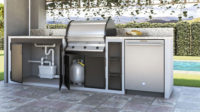With the sheer numbers of Baby Boomers that are now heading into retirement age, they are definitely driving the trend toward aging in place — remodeling their homes so they can live in them longer as they age. But other drivers are influencing this movement, such as multigenerational housing, acute or chronic health conditions and awareness of aging-in-place or universal design products available on the market today.
“For Boomers that we define as Leading Boomers — those who will be 60 to 68 years old in 2014 — it’s about ‘living in place,’ not aging in place,” says Jack Suvak, senior director of market research and insights at Moen. “Living in place could mean in the same home or living in the same community in another, smaller dwelling. What do they have to do to make sure they have a safe, comfortable and stylishly looking home?”
He adds that Boomers have redefined most everything at every life stage and they are redefining what aging means in this country. They will continue to drive remodeling in kitchens and bathrooms, demanding customized components to make their living spaces easily accessible and comfortable for everyone living in the home.
Boomers are looking for the best products that don’t call attention to the fact they need assistance, says Judd Lord, director of industrial design at Delta Faucet. But while Boomers are leading the way, industry manufacturers are looking to expose younger people to these products.
“Trying to make bath and kitchen spaces easier to use, easier to get around — that’s just good design,” he notes. “Many ‘aging-assist’ products today include technology that may attract younger consumers. If these products look great while providing assistance that will be needed later in life, consumers will want to put them into their homes at an earlier age.”
Remodeling in kitchens and baths is on a five- to seven-year cycle, Lord adds, so manufacturers have the opportunity to gravitate consumers toward these products with stylish design. Grab bars are the most obvious aging-in-place accessory in the bathroom. The grab bars of old were clunky and institutional-looking. Today, Delta and American Standard have dual-purpose grab bars built into toilet tissue holders, towel bars and corner shelves in the bath/shower. Although not ADA-compliant, they are rated to handle more weight while looking like fixtures already found in the home.
“No matter what the application, we find that design is one of the key criteria in the decision-making process,” says Kalpesh Nanji, director of product marketing — bathing and independent living at American Standard. “As design has improved, the stigma associated with having accessible products in the home has decreased. Our customers want all these solutions to blend into the design aesthetic of their home or project.”
Kids and grandkids, too
A Pew Research Center analysis of the latest census data found that about 51 million Americans (16.7% of the population) live in a house that has at least two adult generations under one roof. The study notes a 10.5% increase in multigenerational households from 2007 to 2009.
“Multigeneratonal homes are definitely on the rise; more than 3 million grandparents are the primary caregivers for children,” says Diana Schrage, senior staff interior designer at Kohler Co. “That’s something not seen in this country until recently. Today’s aging-in-place products look like just one more amenity one would have in the bathroom, more holistic. I definitely see it becoming part of our design.”
Nanji adds: “In many cases, remodeling a home over moving and buying new has considerable economic advantages and consumers are taking advantage of this. Multigenerational living also is on the rise not only from economic necessity but from increasing cultural diversity where multiple generations living in one household is more common.”
Aquatic Bath conducted a focus-group-like study last year where it went into peoples’ homes in Florida, Texas, Illinois and California and surveyed the goings on in the bathroom.
“It confirmed what we have been seeing. They want to stay in their homes,” Aquatic Director of Marketing and New Product Development Stacy Zar says. “Maybe a parent moved back in with the family or the homeowners realized they will be at that older age one day. Instead of moving, they’re looking into things such as low-threshold-type products or built-in seated showers. People want to stay in their homes longer and we don’t see that turning around anytime soon.”
Because of the different age groups under one roof, industry manufacturers have pushed awareness of these products and they are increasingly more visible and accepted across all life stages, Suvak explains. “Think about kids or pregnant women trying to get in and out of the bathtub or a bath/shower. Why not have a healthy, universally accessible room?” he says.
Health conditions, and not just those of aging consumers, also is an issue. People with broken limbs or people with weight issues may need assistance to get in and out of bathtubs or on and off toilets. Aging-in-place products can help individuals with special needs live better today, says Darryl Jones, regional sales manager at KWC America.
“A universally designed home would already have grab bars and a hand shower installed in place to assist with this restricted movement loss,” he explains. “Taller people may complain of their legs falling asleep when sitting on a traditional water closet. A comfort height or a wall-hung water closet and a heated seat provide the extra height to keep the nerve from being pinched and heat to keep the blood moving.
“And have you ever had to shave your legs in a bathtub? Why wait to add the bench?”
More people are being diagnosed with arthritis, Alzheimer’s, obesity and other physically challenging conditions that require home modifications, Nanji notes. “Consumers seem to be more aware of the solutions and services available to them, leading to increasing focus on products and services that can help people live safer and more comfortably in their homes,” he says.
For people with deteriorating eyesight, task lighting in the bathroom as well as the kitchen is important as a safety issue. Soothing light under bath cabinets, in drawer and even in the toilet seat can help people see where they are going without turning on bright lights and disturbing sleep, Schrage says.
Touchless faucets have moved from the kitchen into the bathroom and now can include color so people can easily see if the water is cold, warm or hot, Lord explains. “Some people lose feeling in fingers and hands as they get older. Colors are easily seen through the steam in a shower.”
More bathroom remodels are including zero-threshold showers with hidden drains, walk-in tubs, wall-hung lavatories and toilets, chair-height toilets, shower and hand-shower systems that are easy to install. Open floor plans that allow greater accessibility for wheelchairs or people with crutches or braces are becoming more popular.
The critical nature of medical supplies such as oxygen or refrigerated medications means generators are becoming more important to consumers as they age, Schrage states. Being without electricity for a long period of time can be a severe health issue; a generator can give comsumers peace of mind.
“The industry will continue to see an integration of technology into the bathroom, kitchen and entire home including wearable technology that will add another level of convenience and monitoring for those who need it,” Nanji adds. “This type of connectivity will address many unmet needs and promises further integration of the benefits into our daily lifestyles.”
Adding aging-in-place services
Contractors need to understand what they are recommending a product for, whether it’s limited mobility or other health conditions, Schrage adds. They may want to partner with an occupational therapist and an interior designer to make an assessment and determine what sort of limitation the customer may have.
“Fortunately, the industry has been changing with consumers’ needs and now many remodelers are focusing on aging in place and other home modifications,” Nanji says. “These remodelers are getting certifications such as Certified Aging in Place Specialist (CAPS professionals) and marketing themselves to this specific demographic. Credibility and trust are a big factor in building sales around these services. Contractors definitely need to get certifications or pursue other educational efforts to get a good grounding in designing, installing and marketing to this segment.”
Zar notes some larger homebuilders now offer layouts for multigenerational living.
Many Baby Boomers did DIY remodeling and repairs in their younger years but some are willing to pay someone to make these living-in-place changes for them, Suvak explains, which bodes well for contractors and CAPS professionals.
“How do consumers transfer from one activity to another? How do you enable people to move in different spaces? Aging-in-place specialists will look at these things,” he says. “They’ll consider people with physical limitations. Maybe they have limited range of motion or flexibility. As diagnoses of dementia increases, aging-in-place professionals will study cognitive limitations as well.”
This will include clearly communicating with the homeowner or the caregiver, Suvak adds — sometimes both. Ask questions to get a better feel of the living environment and who the users are. Boomers are sensitive about their age and reliance on these products, so contractors need to communicate that aging-in-place or universal design products will enable them to live a better quality of life in the home they live in or will move to.












